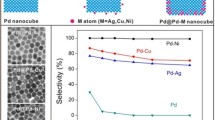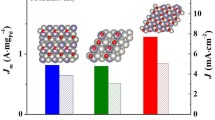Abstract
Metal catalysts play an important role in the catalytic electrochemical processes and optimization of their performance is usually achieved through alloying with other metal atoms. Doping with interstitial hydrogen atoms is a special but effective way to regulate the electronic structure of host catalysts. Herein we demonstrate the intermixing of Pd and Rh atoms during the hydrogen-doping process of Pd@Rh core-shell nanocubes, forming an alloyed surface in Pd@Rh-H. The catalysts show enhanced performance in electrocatalytic methanol oxidation, as compared to commercial Pt/C and are even better than PdH@Rh core-shell nanocubes. The small structural differences between the two hydride catalysts are revealed by X-ray electron spectroscopy and pair distribution function analysis of electron diffraction. The theoretical calculation results show that Rh in Pd@Rh-H contains more negative charges than Rh in PdH@Rh, indicating more effective charge transfer in Pd@Rh-H. The d-band center (εd) of the Rh site in Pd@Rh-H shifts up, and the synergy between Rh and Pd optimizes the binding energy of CO and OH, inducing preferential catalytic activity. Our work provides guidance for the synthesis of high-performance catalysts by doping with interstitial atoms, which may provide a new strategy to fine-tune the electronic structure of other bimetallic nanoparticles.

Similar content being viewed by others
References
Seh, Z. W.; Kibsgaard, J.; Dickens, C. F.; Chorkendorff, I.; Norskov, J. K.; Jaramillo, T. F. Combining theory and experiment in electrocatalysis: Insights into materials design. Science 2017, 355, eaad4998.
Liu, J. Y. Catalysis by supported single metal atoms. ACS Catal. 2017, 7, 34–59.
Guan, E. J.; Ciston, J.; Bare, S. R.; Runnebaum, R. C.; Katz, A.; Kulkarni, A.; Kronawitter, C. X.; Gates, B. C. Supported metal pair-site catalysts. ACS Catal. 2020, 10, 9065–9085.
Xu, S. L.; Shen, S. C.; Wei, Z. Y.; Zhao, S.; Zuo, L. J.; Chen, M. X.; Wang, L.; Ding, Y. W.; Chen, P.; Chu, S. Q. et al. A library of carbon-supported ultrasmall bimetallic nanoparticles. Nano Res. 2020, 13, 2735–2740.
Hui, F.; Li, C.; Chen, Y. H.; Wang, C. H.; Huang, J. P.; Li, A.; Li, W.; Zou, J.; Han, X. D. Understanding the structural evolution of Au/WO2.7 compounds in hydrogen atmosphere by atomic scale in situ environmental TEM. Nano Res 2020, 13, 3019–3024.
Li, L. C.; Dostagir, N. H.; Shrotri, A.; Fukuoka, A.; Kobayashi, H. Partial oxidation of methane to syngas via formate intermediate found for a ruthenium-rhenium bimetallic catalyst. ACS Catal. 2021, 11, 3782–3789.
Liu, C.; Chen, Z. L.; Rao, D. W.; Zhang, J. F.; Liu, Y. W.; Chen, Y. N.; Deng, Y. D.; Hu, W. B. Behavior of gold-enhanced electrocatalytic performance of NiPtAu hollow nanocrystals for alkaline methanol oxidation. Sci. China Mater. 2021, 64, 611–620.
Xu, C. J.; Zhang, Y.; Chen, J.; Li, S.; Zhang, Y. W.; Qin, G. W. Carbon-CeO2 interface confinement enhances the chemical stability of Pt nanocatalyst for catalytic oxidation reactions. Sci. China Mater. 2021, 64, 128–136.
Gong, S. Y.; Zhang, Y. X.; Niu, Z. Q. Recent advances in earth-abundant core/noble-metal shell nanoparticles for electrocatalysis. ACS Catal. 2020, 10, 10886–10904.
Chen, J. Y.; Lim, B.; Lee, E. P.; Xia, Y. N. Shape-controlled synthesis of platinum nanocrystals for catalytic and electrocatalytic applications. Nano Today 2009, 4, 81–95.
Wang, D. S.; Li, Y. D. Bimetallic nanocrystals: Liquid-phase synthesis and catalytic applications. Adv. Mater. 2011, 23, 1044–1060.
Yu, W. T.; Porosoff, M. D.; Chen, J. G. Review of Pt-based bimetallic catalysis: From model surfaces to supported catalysts. Chem. Rev. 2012, 112, 5780–5817.
Zhang, H.; Jin, M. S.; Xia, Y. N. Enhancing the catalytic and electrocatalytic properties of Pt-based catalysts by forming bimetallic nanocrystals with Pd. Chem. Soc. Rev. 2012, 41, 8035–8049.
Gilroy, K. D.; Yang, X.; Xie, S. F.; Zhao, M.; Qin, D.; Xia, Y. N. Shape-controlled synthesis of colloidal metal nanocrystals by replicating the surface atomic structure on the seed. Adv. Mater. 2018, 30, 1706312.
Tao, F.; Grass, M. E.; Zhang, Y. W.; Butcher, D. R.; Renzas, J. R.; Liu, Z.; Chung, J. Y.; Mun, B. S.; Salmeron, M.; Somorjai, G. A. Reaction-driven restructuring of Rh-Pd and Pt-Pd core-shell nanoparticles. Science 2008, 322, 932–934.
Bao, H. B.; Xia, S. Y.; Wu, F. X.; Li, F. H.; Zhang, L.; Yuan, Y. L.; Xu, G. B.; Niu, W. X. Surface engineering of Rh-modified Pd nanocrystals by colloidal underpotential deposition for electrocatalytic methanol oxidation. Nanoscale 2021, 13, 5284–5291.
Bu, L. Z; Zhang, N.; Guo, S. J.; Zhang, X.; Li, J.; Yao, J. L.; Wu, T.; Lu, G.; Ma, J. Y.; Su, D. et al. Biaxially strained PtPb/Pt core/shell nanoplate boosts oxygen reduction catalysis. Science 2016, 354, 1410–1414.
Wang, X.; Choi, S. I.; Roling, L. T.; Luo, M.; Ma, C.; Zhang, L.; Chi, M. F.; Liu, J. Y.; Xie, Z. X.; Herron, J. A. et al. Palladium-platinum core-shell icosahedra with substantially enhanced activity and durability towards oxygen reduction. Nat. Commun. 2015, 6, 7594.
Zhou, M.; Wang, H. L.; Elnabawy, A. O.; Hood, Z. D.; Chi, M. F.; Xiao, P.; Zhang, Y. H.; Mavrikakis, M.; Xia, Y. N. Facile one-pot synthesis of Pd@Pt1L octahedra with enhanced activity and durability toward oxygen reduction. Chem. Mater. 2019, 31, 1370–1380.
Deng, Y. J.; Tripkovic, V.; Rossmeisl, J.; Arenz, M. Oxygen reduction reaction on Pt overlayers deposited onto a gold film: Ligand, strain, and ensemble effect. ACS Catal. 2016, 6, 671–676.
Van Cleve, T.; Moniri, S.; Belok, G.; More, K. L.; Linic, S. Nanoscale engineering of efficient oxygen reduction electrocatalysts by tailoring the local chemical environment of Pt surface sites. ACS Catal. 2017, 7, 17–24.
Xin, H. L.; Holewinski, A.; Linic, S. Predictive structure-reactivity models for rapid screening of Pt-based multimetallic electrocatalysts for the oxygen reduction reaction. ACS Catal. 2012, 2, 12–16.
Kitchin, J. R.; Nørskov, J. K.; Barteau, M. A.; Chen, J. G. Role of strain and ligand effects in the modification of the electronic and chemical properties of bimetallic surfaces. Phys. Rev. Lett. 2004, 93, 156801.
Zhu, J. W.; Lyu, Z. H.; Chen, Z. T.; Xie, M. H.; Chi, M. F.; Jin, W. Q.; Xia, Y. N. Facile synthesis and characterization of Pd@IrnL (n = 1–4) core-shell nanocubes for highly efficient oxygen evolution in acidic media. Chem. Mater. 2019, 31, 5867–5875.
Chan, C. W. A.; Mahadi, A. H.; Li, M. M. J.; Corbos, E. C.; Tang, C.; Jones, G.; Kuo, W. C. H.; Cookson, J.; Brown, C. M.; Bishop, P. T. et al. Interstitial modification of palladium nanoparticles with boron atoms as a green catalyst for selective hydrogenation. Nat. Commun. 2014, 5, 5787.
Jiang, K.; Xu, K.; Zou, S. Z.; Cai, W. B. B-Doped Pd catalyst: Boosting room-temperature hydrogen production from formic acid-formate solutions. J. Am. Chem. Soc. 2014, 136, 4861–4864.
Li, J.; Chen, J. X.; Wang, Q.; Cai, W. B.; Chen, S. L. Controllable increase of boron content in B-Pd interstitial nanoalloy to boost the oxygen reduction activity of palladium. Chem. Mater. 2017, 29, 10060–10067.
Guo, R. Y.; Chen, Q.; Li, X.; Liu, Y. M.; Wang, C. Q.; Bi, W.; Zhao, C. Y.; Guo, Y. J.; Jin, M. S. PdCx nanocrystals with tunable compositions for alkyne semihydrogenation. J. Mater. Chem. A 2019, 7, 4714–4720.
Fan, J. C.; Cui, X. Q.; Yu, S. S.; Gu, L.; Zhang, Q. H.; Meng, F. Q; Peng, Z. Q.; Ma, L. P.; Ma, J. Y.; Qi, K. et al. Interstitial hydrogen atom modulation to boost hydrogen evolution in Pd-based alloy nanoparticles. ACS Nano 2019, 13, 12987–12995.
Fan, J. C.; Wu, J. D.; Cui, X. Q.; Gu, L.; Zhang, Q. H.; Meng, F. Q.; Lei, B. H.; Singh, D. J.; Zheng, W. T. Hydrogen stabilized RhPdH 2D bimetallene nanosheets for efficient alkaline hydrogen evolution. J. Am. Chem. Soc. 2020, 142, 3645–3651.
Kim, J.; Kim, H.; Lee, W. J.; Ruqia, B.; Baik, H.; Oh, H. S.; Paek, S. M.; Lim, H. K.; Choi, C. H.; Choi, S. I. Theoretical and experimental understanding of hydrogen evolution reaction kinetics in alkaline electrolytes with Pt-based core-shell nanocrystals. J. Am. Chem. Soc. 2019, 141, 18256–18263.
Favier, F.; Walter, E. C.; Zach, M. P.; Benter, T.; Penner, R. M. Hydrogen sensors and switches from electrodeposited palladium mesowire arrays. Science 2001, 293, 2227–2231.
Yang, F.; Kung, S. C.; Cheng, M.; Hemminger, J. C.; Penner, R. M. Smaller is faster and more sensitive: The effect of wire size on the detection of hydrogen by single palladium nanowires. ACS Nano 2010, 4, 5233–5244.
Adhikari, S.; Fernando, S. Hydrogen membrane separation techniques. Ind. Eng. Chem. Res. 2006, 45, 875–881.
Horinouchi, S.; Yamanoi, Y.; Yonezawa, T.; Mouri, T.; Nishihara, H. Hydrogen storage properties of isocyanide-stabilized palladium nanoparticles. Langmuir 2006, 22, 1880–1884.
Li, G. Q.; Kobayashi, H.; Taylor, J. M.; Ikeda, R.; Kubota, Y.; Kato, K.; Takata, M.; Yamamoto, T.; Toh, S.; Matsumura, S. et al. Hydrogen storage in Pd nanocrystals covered with a metal-organic framework. Nat. Mater. 2014, 13, 802–806.
Baldi, A.; Narayan, T. C.; Koh, A. L.; Dionne, J. A. In situ detection of hydrogen-induced phase transitions in individual palladium nanocrystals. Nat. Mater. 2014, 13, 1143–1148.
Bardhan, R.; Hedges, L. O.; Pint, C. L.; Javey, A.; Whitelam, S.; Urban, J. J. Uncovering the intrinsic size dependence of hydriding phase transformations in nanocrystals. Nat. Mater. 2013, 12, 905–912.
Rose, A.; Maniguet, S.; Mathew, R. J.; Slater, C.; Yao, J.; Russell, A. E. Hydride phase formation in carbon supported palladium nanoparticle electrodes investigated using in situ EXAFS and XRD. Phys. Chem. Chem. Phys. 2003, 5, 3220–3225.
Murphy, D. W.; Zahurak, S. M.; Vyas, B.; Thomas, M.; Badding, M. E.; Fang, W. C. A new route to metal hydrides. Chem. Mater. 1993, 5, 767–769.
Zhao, Z. P.; Huang, X. Q.; Li, M. F.; Wang, G. M.; Lee, C.; Zhu, E. B.; Duan, X. F.; Huang, Y. Synthesis of stable shape-controlled catalytically active β-palladium hydride. J. Am. Chem. Soc. 2015, 137, 15672–15675.
Zhan, C. Y.; Li, H. Q.; Li, X. M.; Jiang, Y. Q.; Xie, Z. X. Synthesis of PdH0.43 nanocrystals with different surface structures and their catalytic activities towards formic acid electro-oxidation. Sci. China Mater. 2020, 63, 375–382.
Jin, M. S.; Liu, H. Y.; Zhang, H.; Xie, Z. X.; Liu, J. Y.; Xia, Y. N. Synthesis of Pd nanocrystals enclosed by {100} facets and with sizes < 10 nm for application in CO oxidation. Nano Res. 2011, 4, 83–91.
Choi, S. I.; Young, A.; Lee, S. R.; Ma, C.; Luo, M.; Chi, M. F.; Tsung, C. K.; Xia, Y. N. Pd@Rh core-shell nanocrystals with well-defined facets and their enhanced catalytic performance towards CO oxidation. Nanoscale Horiz. 2019, 4, 1232–1238.
Kibis, L. S.; Stadnichenko, A. I.; Koscheev, S. V.; Zaikovskii, V. I.; Boronin, A. I. XPS study of nanostructured rhodium oxide film comprising Rh4+ species. J. Phy. Chem. C 2016, 120, 19142–19150.
Kobayashi, H.; Yamauchi, M.; Kitagawa, H.; Kubota, Y.; Kato, K.; Takata, M. Hydrogen absorption in the core/shell interface of Pd/Pt nanoparticles. J. Am. Chem. Soc. 2008, 130, 1818–1819.
Kobayashi, H.; Yamauchi, M.; Kitagawa, H.; Kubota, Y.; Kato, K.; Takata, M. Atomic-level Pd-Pt alloying and largely enhanced hydrogen-storage capacity in bimetallic nanoparticles reconstructed from core/shell structure by a process of hydrogen absorption/desorption. J. Am. Chem. Soc. 2010, 132, 5576–5577.
Dekura, S.; Kobayashi, H.; Kusada, K.; Kitagawa, H. Hydrogen in palladium and storage properties of related nanomaterials: Size, shape, alloying, and metal-organic framework coating effects. ChemPhysChem 2019, 20, 1158–1176.
Ferrin, P.; Nilekar, A. U.; Greeley, J.; Mavrikakis, M.; Rossmeisl, J. Reactivity descriptors for direct methanol fuel cell anode catalysts. Surf. Sci. 2008, 602, 3424–3431.
Acknowledgements
This work was financially supported by the Natural Science Foundation of Tianjin, China (No. 18JCYBJC20600) and Institute of Energy, Hefei Comprehensive National Science Center (No. 19KZS207), the National Key R&D Program of China (No. 2020YFA0406101), the National Natural Science Foundation of China (No. 21701168), Dalian high level talent innovation project (No. 2019RQ063).
Author information
Authors and Affiliations
Corresponding authors
Electronic supplementary material
Rights and permissions
About this article
Cite this article
Guo, X., Hu, Z., Lv, J. et al. Fine-tuning of Pd-Rh core-shell catalysts by interstitial hydrogen doping for enhanced methanol oxidation. Nano Res. 15, 1288–1294 (2022). https://doi.org/10.1007/s12274-021-3652-0
Received:
Revised:
Accepted:
Published:
Issue Date:
DOI: https://doi.org/10.1007/s12274-021-3652-0




